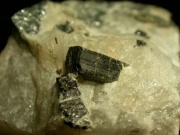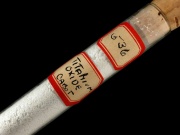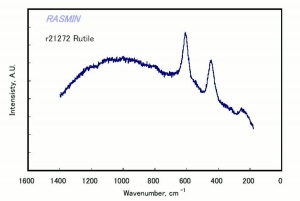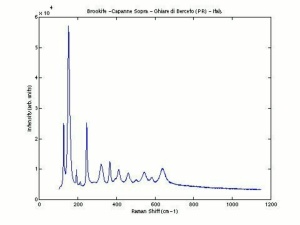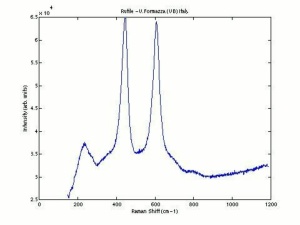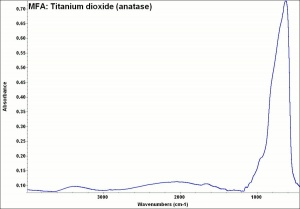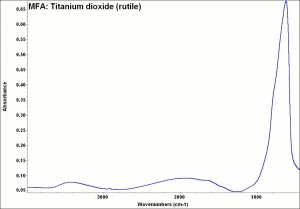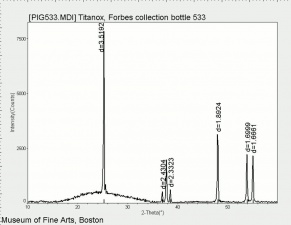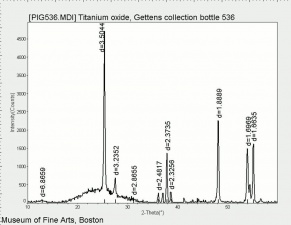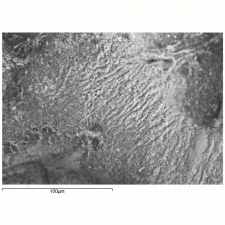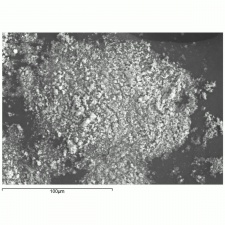Titanium dioxide
Description
A dense, white, opaque powder often used as a pigment. Titanium dioxide occurs naturally in three crystalline forms: anatase, rutile and brookite. It is a very stable compound with a high refractive index. A pale yellow titanium dioxide pigment was prepared from ground rutile as early as 1870. Synthetic titanium white (anatase form) was first prepared in 1908 in Niagara Falls, NY. Commercial manufacturing of the pigment began in the U. S. (Titanium Pigment Corp.) in 1916 and in Norway (Titan Co.) in 1918; by 1920, the two companies signed an agreement to cross license the product prepared using the Norwegian patent (Laver 1997). The pigment was sold under the name of Titanox and contained 25% titanium dioxide co-precipitated with 75% sulfate barium sulfate. Both pure titanium and barium base titanium pigments have a very fine texture. The anatase form of titanium dioxide was a common white pigment in the early 20th century. Once the first commercially viable method for producing rutile was developed in 1938, production shifted to rutile because white paints with anatase pigments were subject to chalking and yellowing. Currently, titanium pigments are usually sold as admixtures with oxide zinc oxide. In addition to paints, titanium dioxide is used as a pigment in paper coatings, textiles, leather, ink, glass, and ceramic glazes. It is also used as an abrasive. Synthetic titanium dioxide (rutile) is also produced as a gemstone crystal by the Verneuil process for use as imitation diamonds in paste jewelry.
Synonyms and Related Terms
titanium white; rutile; anatase; brookite; Pigment White 6; CI 77891; dioxyde de titane (Fr.); Titandioxid (Deut., Sven.); bianco di titanio (It.); dixido de titanio (Esp.); titandioksid (Nor.); dixido de titnio (Port.); titania; titanic anhydride; titanic acid anhydride; titanic oxide; Unitane; Titanox
Other Properties
Particle size = 0.2-0.5 micrometers.
may fluoresce a deep purple in ultraviolet light; mixtures with zinc oxide fluoresce green-yellow.
Resistant to acids and alkalis. Insoluble in water.
| Composition | TiO2 |
|---|---|
| CAS | 13463-67-7 |
| Mohs Hardness | 6.0-6.5 |
| Melting Point | 1640 (dec) |
| Density | 4.26 |
| Molecular Weight | mol. wt. = 79.9 |
| Refractive Index | 2.5-2.7 |
Hazards and Safety
Nontoxic. Noncombustible.
No significant hazards.
LINK: International Chemical Safety Card
Additional Information
M.Laver, "Titanium Dioxide Whites", Artists Pigments, Volume 3, E. West FitzHugh (ed.), Oxford University Press: Oxford, 1997. Walter C. McCrone, "Polarized Light Microscopy in Conservation: A Personal Perspective" JAIC 33(2):101-14, 1994. (contains a table of dates on the history of titanium white as a pigment)
Comparisons
Properties of Common Abrasives
Natural and Simulated Diamonds
Characteristics of Common White Pigments
Authority
- The Dictionary of Art, Grove's Dictionaries Inc., New York, 1996 Comment: "Pigments"
- Artists' Pigments: A Handbook of their History and Characteristics, Elisabeth West FitzHugh, Oxford University Press, Oxford, Vol. 3, 1997 Comment: M.Laver, "Titanium Dioxide Whites" -In Norway, production of TiO2 patented in 1913, and pigment production in November 1918 (Titan Co. In U.S., patent applications filed in 1912 and production of a composite pigment began in 1916.
- R. J. Gettens, G.L. Stout, R. J. Gettens, G.L. Stout, Painting Materials, A Short Encyclopaedia, Dover Publications, New York, 1966
- Ralph Mayer, Ralph Mayer, A Dictionary of Art Terms and Techniques, Harper and Row Publishers, New York, 1969 (also 1945 printing)
- Matt Roberts, Don Etherington, Matt Roberts, Don Etherington, Bookbinding and the Conservation of Books: a Dictionary of Descriptive Terminology, U.S. Government Printing Office, Washington DC, 1982
- Dictionary of Building Preservation, Ward Bucher, ed., John Wiley & Sons, Inc., New York City, 1996 Comment: Pigment available in 1918
- The Merck Index, Martha Windholz (ed.), Merck Research Labs, Rahway NJ, 10th edition, 1983 Comment: entry 9612
- Reed Kay, Reed Kay, The Painter's Guide To Studio Methods and Materials, Prentice-Hall, Inc., Englewood Cliffs, NJ, 1983
- Hoechst Celanese Corporation, Hoechst Celanese Corporation, Dictionary of Fiber & Textile Technology (older version called Man-made Fiber and Textile Dictionary, 1965), Hoechst Celanese Corporation, Charlotte NC, 1990
- Michael McCann, Michael McCann, Artist Beware, Watson-Guptill Publications, New York City, 1979
- C.W.Chesterman, K.E.Lowe, C.W.Chesterman, K.E.Lowe, Audubon Society Field Guide to North American Rocks and Minerals, Alfred A. Knopf, New York, 1979 Comment: density=4.2-4.3, hardness=6.0-6.5
- Thomas B. Brill, Thomas B. Brill, Light Its Interaction with Art and Antiquities, Plenum Press, New York City, 1980
- M. de Keijzer, M. de Keijzer, 'A survey of red and yellow modern synthetic organic artists pigments discovered in the 20th century and used in oil colors', ICOM Preprints Lyons, France, Getty Conservation Institute, Los Angeles, p. 369, 1999
- Wikipedia, the free encyclopedia, at http://www.wikipedia.com Comment: http://en.wikipedia.org/wiki/Titanium_dioxide (Accessed Sept. 17, 2005)
- Richard S. Lewis, Richard S. Lewis, Hawley's Condensed Chemical Dictionary, Van Nostrand Reinhold, New York, 10th ed., 1993
- Susan E. Schur, Susan E. Schur, Conservation Terminology: A review of Past & Current Nomenclature of Materials, Technology and Conservation, Spring (p.34-39); Summer (p.35-38); Fall (p.25-36), 1985 Comment: Artists pigments sold in mid 1920s
- Book and Paper Group, Book and Paper Group, Paper Conservation Catalog, AIC, 1984, 1989
- External source or communication, External source or communication Comment: Submission by N. Marco 8/25/05.
- Website address 1, Website address 1 Comment: Pigments Through the Ages -http://webexhibits.org/pigments/indiv/overview/tiwhite.html
